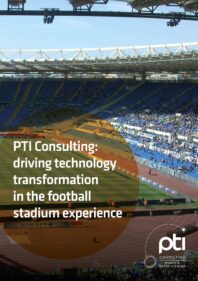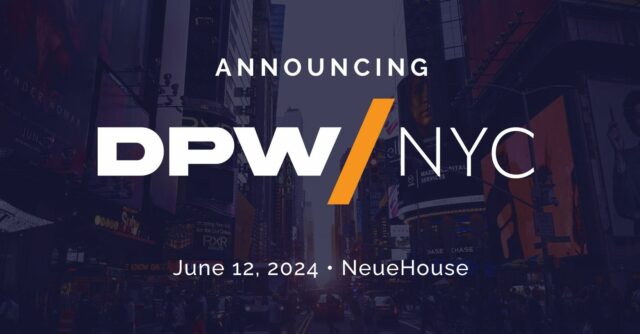Mike Bohndiek, Managing Director of PTI Consulting and Eric Solem, Head of Business Applications speak exclusively to The Interface on how the company helps sporting organisations unlock their stadium technology transformations to enhance the fan and customer experience
When we look at the current Stadium Technology Transformation landscape, what are some of the cultural differences between the approaches in the UK and those in Italy?
Eric Solem, Head of Business Applications and Commercial at PTI: The fundamental difference concerns the ownership of the grounds. Here in the UK the rights holders (the teams) actually own the grounds or have some major sort of participation in ownership whereas most grounds in Italy, except for a few cases, are owned by the local councils. And so, therefore, they’re fundamentally rented facilities. They’re not necessarily facilities that have had the experiential strategy piece built around it, and that’s a real struggle most Italian clubs have. AS Roma is a great example where they play out of a shared Stadia (Olympic Stadium) between arch-rivals (Lazio) and on match day everything has to be quickly loaded in and then taken out (pre and post-match). Along with this you don’t have the added benefits of stadium tours, etc. This all adds up to the stadium not being designed the exact way you want them to be designed and you lose that sense of home, of it being the ‘Club Stadium’.
How does that impact the way that the club makes their decisions on where they invest in the technology infrastructure across the Stadium?
Eric: Well, the majority of the clubs across Italian football are considered to be well behind the rest of Europe’s top leagues, mostly due to the lack of investment in stadia. I think that’s mainly due to the difficulty of just getting things done in Italy, especially the financing laws of certain criteria. There’s a long history around why this hasn’t happened, but in the case of Juventus, they managed to rebuild a new modern stadium within their old stadium. Now, they’ve won the title eight years running and are one of the most successful teams in Europe and have new revenue streams from having their own stadium.
Most of the clubs want to follow this model and AS Roma are looking at the approval of a big project. There are other examples of clubs like Sassuolo and Udinese who’ve done smaller redevelopment projects. There are a lot of other ones that are in the rendering phase, but I think it’s a well-known and documented issue that Italian football revenues have been in decline since the late 90s when it was considered the Premier League across Europe.
In the UK, you can look at Arsenal as a great example in 2006 with their new stadium and then there have been a lot of other redevelopments after that…all leading up to Arsenal’s friends across north London with Tottenham Hotspur’s state of the art brand-new stadium.
Mike Bhondiek, Managing Director, PTI: The challenge is about who owns the customer journey and that fan experience. It’s the hot buzz phrase right now and we need to look at what are clubs doing to drag people back off the sofa, back out of the bars and back out of watching broadcast TV into having the real stadium experience.
The real challenge across the last six/seven years is that broadcast packages have become cheaper and more accessible, whilst ticket prices have gone in the opposite direction! Consumers now have the ‘game’ choice between the stadium experience or whether they prefer the experience at home! Which takes us to the connectivity with your device/technology. At home, the fans have more configurability of their surroundings and are connected to quality Wi-Fi. They can look across the statistics, they can be on their device orchestrating what they want, something they’ll struggle to do across almost every stadium.
On the opposite end of that scale is the American-style whole day experience that some clubs have started to move towards in the UK. In nearly all cases the stadiums are owned outright by the club, therefore you’ve got full control of everything that goes on around the stadium (the very opposite of the Italian model of leaseholds of the ground) and with the charge of the digital agenda and social media, you’re able to drive awareness and engagement with what you’re doing around the stadium.
However, it doesn’t always flow through into reality and most people just take that digital experience in isolation. Clubs are looking to take more control of that end-to-end immersive experience, and that starts with the ticket purchase and runs through to the post-match survey, providing a real competitive advantage for those clubs who are doing this well!
Eric: I think that’s a very good point. For a lot of fans, it doesn’t feel like going to your home ground, much more of a temporary rented stadia experience. All of which makes the competition of getting people off the couch, back into this connected area a big challenge for Italian clubs. If a fan doesn’t feel like they’re coming to a place where they belong (and part of the club experience) that whole journey sort of breaks down.
From a technology perspective, are there any differences between the average Roma fan and the Arsenal fan…or are they both looking for very much the same thing?
Eric: No, I don’t think there is any difference at all. The passion of fans is the same, they want to know everything about the club, so who trained on that day, who’s injured, what are the prospective new players coming into the club, etc. They want as much access as possible and with digital media broadcasting (YouTube) that is here together with social media, that has allowed that to happen. I think fans feel a lot closer to the club from that aspect, but you need that stadium piece to complete the circle.
Are there any differences in how fans interact with the stadium? Do they arrive earlier, and do they spend differently across food/beverage and merchandise?
Eric: Again, it comes back to the challenge of not owning your ground. For example, in Rome, we were restricted by security as to how we could operate the building and there wasn’t much possibility of a pop-up fan zone on match day to engage with the fans. I think you’ll find at some clubs like Juventus and Sassuolo there is more of an improved fan experience, but it’s still way behind the UK and the US model.
Mike: The fundamental difference when we talk about culture is more interesting when we compare the US versus UK/European models. The PTI Consulting trip to the US was interesting to compare the ticketing model, especially in baseball where there’s little scarcity and it’s a far greater number of matches than there are in football. Casual transient supporters who might come only a handful of times a year can get a ticket when they want, whereas the model in England is very much seasonal.
Typically, 85% of the top English football clubs tickets ever sold is on a seasonal basis. West Ham sold 47k season tickets in a 52k capacity stadium and Arsenal sold 47k out the 60k Stadium when they moved into Emirates. The model is built around banking money up front and then creating engagement on a different model.
A lot of clubs have evolved over the years, which has bred a match day routine that has now become a challenge for the club to change. People tend to do the same things they’ve always done, regardless of whether you change the experience for them because it’s their habit/superstition and has become part of what makes match day for them.
So, you’ve really got to be focused to not only match the experience that those people have always had, but beat it, make it such a draw them to leave their usual pubs/restaurants and come back to the stadium. The US model is different because it’s built for around 30% being seasonal with the rest being more transient. That new fan comes for the first time, they’re arriving at the ground early and they won’t have a preset routine. They want to engage with the fan part. They tend to spend across secondary revenue through retail, through food and beverage and create that big experiential day. Some fans want to lap up every last moment of this match day. How early could I get there? And how late can I leave?
People coming to have a great experience is one thing, but how do you create value to that season ticket holder that’s been going for many years and ensure they’re still getting the most value out of their match day? That includes the operational experience, so I can go to the pub until 14:55 and still be in my seat by kick-off. Then you wonder, can you make access control a seamless experience?
What can the UK and European Clubs look to the US for in terms of what they’re doing from a technology point of view?
Eric: In the US there’s a pretty constant rate of a refresh and that is actual physical experiential refresh. You see big arenas and stadiums in the US now moving away from suites and putting lounge seats in. For example, we recently visited Madison Square Garden, which has gone through this complete refurbishment of the club spaces to the lounge model.
I know that Roma/Italian/French fans, they want that new modern stadium experience. They want those experiential pieces to add to the match day excitement. But after that first season of the new stadium, how do you keep those same fans engaged? And how do you keep them coming back for more and not falling into the old habits of showing up half an hour before kick-off and leaving immediately after the game? The solution for this is through the creative use of technology.
Some of the experiential pieces can have the ability to plug-n-play different types of experiences when you have a new building, as it has the infrastructure built in to allow you to do that. So, you’re not ripping down walls and pulling out cables every time you want to do a new experiential piece. I think part of it is how clubs and the stadia usage evolve over time and refresh constantly maybe every three to five years or even at a greater rate of change. You need to provide something new to compete with the wide variety of entertainment choices that the casual fan has. So, the rate of technology change is going to continue to increase.
Mike: The UK in many ways has this technology challenge. In the US they tend to build the stadium within a greenfield site. It will generally be an out-of-town building, with the infrastructure designed to do this well from the ground up.
I’ve reviewed a lot of UK stadiums and for the most part, they have a pre-existing technology legacy that is way out of date. There was a wave that was built in the 1970s, another in the 1990s and the last wave the early 2000s. Today they’re all starting to get to that point where they simply don’t meet the technological needs of the modern fan. So, we’ve seen some clubs decide to do that refresh by rebuilding a stand, some do it by moving the whole stadium, others do it just by overlaying new technology services, all in an attempt to try and improve that fan experience.
So, yes “I’d like to use that fancy new club app” but you’re letting me down with the 1993 technology infrastructure unable to cope with the new app sitting on top of it. Whereas, if you’re getting the US model, and you’re building from the greenfield, you’re building the infrastructure up from the base. So, starting with a really strong pyramid base and you’re on the way to better understand the full journey. You’re also building in some headroom for the next ten years and future proofing fan behaviour and expectation.
We see a lot of clients attempt to unpick their technology to try to get to that same position. However, if you’re in a stadium that was built in the early 1900’s it becomes more difficult to fully understand how technology can fit into this environment and as such creates a real challenge.
What is the key thing that clubs need to look at to create engagement to drive commercial growth through fan engagement?
Eric: We talk about the pyramid of technology, data, applications and connectivity. So, everyone feels the need to have a robust fan app. Yes, everyone falls in love with these apps, but I think clubs need to step back and understand how this application works within your building, by looking at the infrastructure and looking at your connectivity.
Those three things need to be looked at holistically because at the end of that journey they’re going to produce the data that provides commercial growth or operational efficiency, which is what all stadia and all clubs should be looking for when they’re investing in technology
Mike: My number one piece of advice is to look at your connectivity. The rate of change is increasing and services from the cloud are the type models your fans want from your infrastructure. Also, the ticketing platform and access control systems are the sorts of key items that surround your customer touch-point, so it’s fundamental that these systems work every single time!
Over the next two years, 5G will slot into view with a chance to commercialise this across Europe. New stadium projects will need to factor that future piece ahead because you need to decide whether it is Wi-Fi handing off to mobile data or create a spot for mobile data.
You also need to factor the connectivity needs of your match day experience for the back-of-house operations (such as scanning stock, retail warehousing, store replenishment) so the customer experience is amazing at half time and at the end of the match. Fans expect the food & beverage tills to be built on cloud platforms and use contactless payment solutions.
The fan experience is always changing, and we will see mobile with augmented reality very soon, so how will you deliver that without connectivity?












